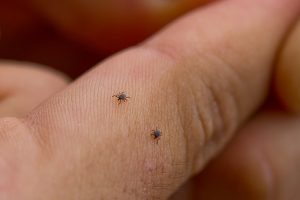 Lyme disease 2016 update: The capital of Canada – Ottawa – has seen Lyme disease cases triple, a former Real Housewives of New Jersey star has come out about her diagnosis, and global warming may increase the risk of Lyme disease.
Lyme disease 2016 update: The capital of Canada – Ottawa – has seen Lyme disease cases triple, a former Real Housewives of New Jersey star has come out about her diagnosis, and global warming may increase the risk of Lyme disease.
Cases of Lyme disease in Ottawa, Canada, have tripled since last year. Researchers suggest that the spike in cases not only reveals an increase in infected ticks but also a heightened awareness of Lyme disease. Experts suggest that rates may continue to be on the rise throughout this summer.
Advertisement
Lyme disease is still on the incline in both Canada and the U.S. In Ottawa alone, a ten-fold increase in Lyme disease cases from 2010 to 2015 has been uncovered.
There were 70 cases of Lyme disease reported last year – a drastic change from just 22 in 2014.
Aside from Ottawa, Lyme-infected ticks have also been found in Kingston and Leeds-Greenville (Canada).
Real Housewives of New Jersey alumna reports Lyme disease diagnosis
A former star of the Real Housewives of New Jersey has come out about her Lyme disease diagnosis. The celebrity who has previously battled with breast cancer was diagnosed with Lyme disease early June 2016. The star states she began feeling as if she had the flu, along with awful joint pain.
The good news is, because it was caught so early, she will not require immense treatment and can still undergo her chemotherapy for breast cancer. Lyme disease will continue to be monitored.
Global warming increases the risk of Lyme disease
The rising temperatures increase the risk of Lyme disease throughout North America. As global warming continues to take its toll, we get longer summers and warmer winters. Although nicer weather is always welcome, it also means that the black-legged ticks (the ticks that transmit Lyme disease) can stick around for much longer as well.
Normally black-legged ticks, or deer ticks, die off in the winter, but now when the temperatures aren’t dropping as much, the ticks continue to live even when they should have long gone. With longer summers, there is more time to be exposed to deer ticks. In prior years, walking through a forest in the fall when it was colder wouldn’t increase your risk of Lyme disease. Now, the temperatures are higher, so there are more deer ticks alive by the time fall season arrives.
But you don’t have to let the fear of tick bites prevent you from enjoying the outdoors. Here are some tips to help you prevent Lyme disease.
- If you are headed outside, check your clothing or skin frequently for tick bites.
- Wear light-colored clothing so ticks are more visible.
- If you are in a wooded area, ensure you are well covered so that the ticks cannot find accessible blood vessels to bite.
- Use insecticide permethrin on your clothing and camping equipment to ward off ticks.
- Remove ticks immediately with tweezers, but do not squeeze them as they can still stay in the skin. Pull away for the skin gently to ensure the bug is completely removed.
Although it is unclear how long it takes for Lyme disease to set in, the rule of thumb is, the longer the tick remains latched on, the higher the risk, so remove it as soon as possible to reduce your risk of infection.
Related Reading:
Tick-borne illnesses, Lyme disease, treated in mice with combination therapy
A new study has found that combination therapy is successful in treating tick-borne illnesses, like Lyme disease, in mice. The researchers found the combination therapy cured babesiosis, which is an emerging threat transmitted by the same ticks that spread Lyme disease. Continue reading…
Advertisement
Lyme disease can prevent the immune system from developing lasting immunity: Study
Lyme disease can prevent the immune system from developing lasting immunity, according to research. The findings come from the researchers at the University of California who found that Lyme disease can trick the animal’s immune system, which fails to send an immune response or develop lasting immunity to the disease as a result. Continue reading…
Sources:
http://ottawacitizen.com/news/local-news/number-of-lyme-disease-cases-in-ottawa-more-than-triple-in-2015
http://www.usmagazine.com/celebrity-news/news/rhonj-alum-amber-marchese-has-lyme-disease-w210913
http://www.womenshealthmag.com/health/lyme-disease-climate-change
